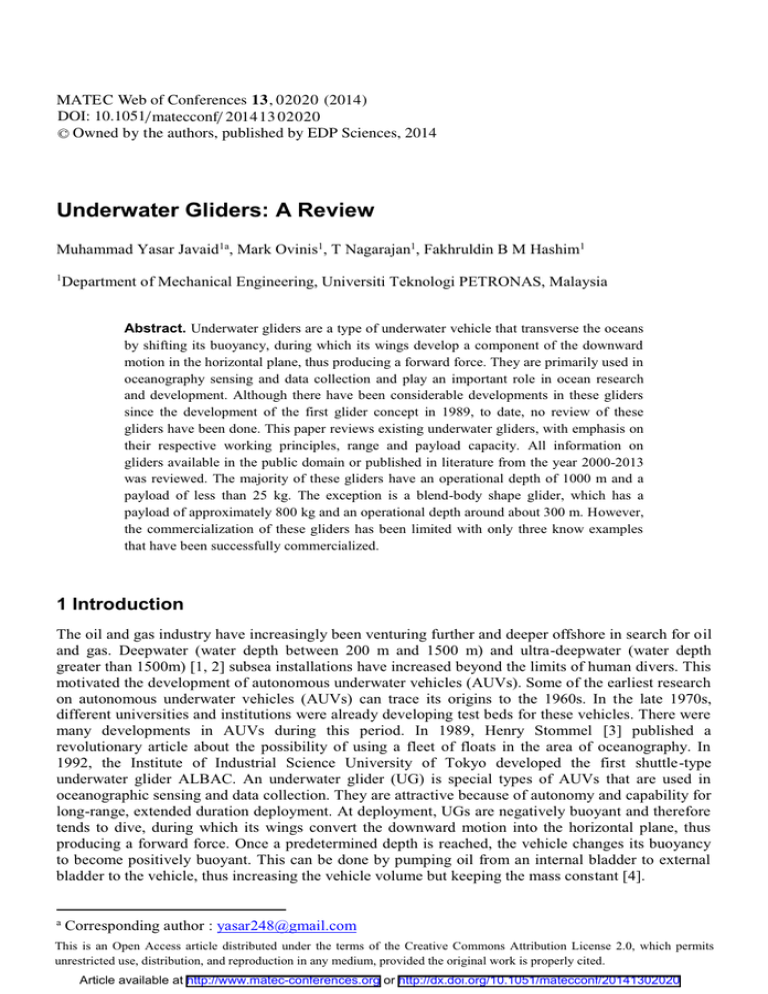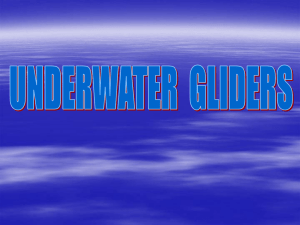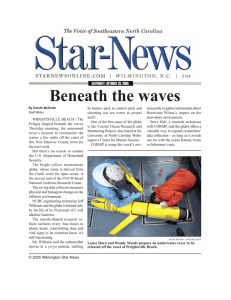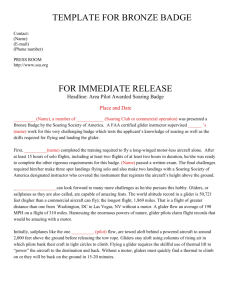, 02020 (2014) Web of Conferences MATEC
advertisement

MATEC Web of Conferences 13 , 02020 (2014) DOI: 10.1051/matecconf/ 201 4 13 02020 C Owned by the authors, published by EDP Sciences, 2014 Underwater Gliders: A Review Muhammad Yasar Javaid1a, Mark Ovinis1, T Nagarajan1, Fakhruldin B M Hashim1 1 Department of Mechanical Engineering, Universiti Teknologi PETRONAS, Malaysia Abstract. Underwater gliders are a type of underwater vehicle that transverse the oceans by shifting its buoyancy, during which its wings develop a component of the downward motion in the horizontal plane, thus producing a forward force. They are primarily used in oceanography sensing and data collection and play an important role in ocean research and development. Although there have been considerable developments in these gliders since the development of the first glider concept in 1989, to date, no review of these gliders have been done. This paper reviews existing underwater gliders, with emphasis on their respective working principles, range and payload capacity. All information on gliders available in the public domain or published in literature from the year 2000-2013 was reviewed. The majority of these gliders have an operational depth of 1000 m and a payload of less than 25 kg. The exception is a blend-body shape glider, which has a payload of approximately 800 kg and an operational depth around about 300 m. However, the commercialization of these gliders has been limited with only three know examples that have been successfully commercialized. 1 Introduction The oil and gas industry have increasingly been venturing further and deeper offshore in search for oil and gas. Deepwater (water depth between 200 m and 1500 m) and ultra-deepwater (water depth greater than 1500m) [1, 2] subsea installations have increased beyond the limits of human divers. This motivated the development of autonomous underwater vehicles (AUVs). Some of the earliest research on autonomous underwater vehicles (AUVs) can trace its origins to the 1960s. In the late 1970s, different universities and institutions were already developing test beds for these vehicles. There were many developments in AUVs during this period. In 1989, Henry Stommel [3] published a revolutionary article about the possibility of using a fleet of floats in the area of oceanography. In 1992, the Institute of Industrial Science University of Tokyo developed the first shuttle-type underwater glider ALBAC. An underwater glider (UG) is special types of AUVs that are used in oceanographic sensing and data collection. They are attractive because of autonomy and capability for long-range, extended duration deployment. At deployment, UGs are negatively buoyant and therefore tends to dive, during which its wings convert the downward motion into the horizontal plane, thus producing a forward force. Once a predetermined depth is reached, the vehicle changes its buoyancy to become positively buoyant. This can be done by pumping oil from an internal bladder to external bladder to the vehicle, thus increasing the vehicle volume but keeping the mass constant [4]. a Corresponding author : yasar248@gmail.com This is an Open Access article distributed under the terms of the Creative Commons Attribution License 2.0, which permits unrestricted use, distribution, and reproduction in any medium, provided the original work is properly cited. Article available at http://www.matec-conferences.org or http://dx.doi.org/10.1051/matecconf/20141302020 MATEC Web of Conferences 2 Underwater Gliders ALBAC was first prototype glider that moved by gliding without any propeller system [5] as shown in fig 1-a. It had a cylindrical body with wings to develop maximum lift force and actuators to control the buoyancy of the glider [6]. It was designed to carry scientific measurement devices to a fixed destination at a 20 degree gliding angle. After reaching its destination at depth 300 m, it becomes positive buoyant. The trajectory is controlled by changing the centre of buoyancy. Figure. 1 a-ALBAC Glider, b-Spray, c-Seaglider, [7] In 1995 The Naval Research's Autonomous Oceanographic Sampling Network (AOSN) developed three underwater gliders Slocum, Spray and Seaglider, similar in size and design [8] for oceanographic sampling. The Webb Research Corp’s (WRC) optimized the Slocum for missions in shallow coastal environments which required fast turning and vertical velocity [9]. It had a single stroke pump to shift water in and out for volume control. A rudder was used to control the turning movement and pitch control was by shifting mass. The hull material strength to weight ratio and the capacity of single stoke pump for volume control limited its operation at higher depths. The Scripps Institution of Oceanography’s (SIO) overcome these limitations by developing a hull with 50% higher drag then the Slocum and used a reciprocating pump capable of operating under higher pressure. This resulting glider, known as ‘Spray’’ [10] were electric-powered vehicle optimized for use in the deep ocean where a long duration is paramount. The University of Washington’s designed ‘‘Seaglider’’ enclose in a hydrodynamic fiberglass fairing supporting wings, vertical stabilizer and tailing antenna[11, 12] as shown in fig 1-b. It had low drag hydrodynamic shape that retained a laminar boundary layer forward of its maximum diameter. By improving the strength and hydrodynamic shape of the hull in 2002 [13], they developed Deepglider, which was similar in size to the Seaglider. The hull of glider attained a maximum strength to weight ratio by using the thermoset resin and carbon fibres to achieve a 6000 m operational depth. The buoyancy engine of the Deepglider is identical to the Seaglider, the difference being its ability to work under high pressure and control more volume due to the capacity of its buoyancy controls actuators, shown in fig 2. The Webb Research Corp’s (WRC) developed Slocum Thermal for long duration missions in waters with a well-developed thermocline [9, 14]. Because temperature and heat vary at the different depths, heat is absorbed and released, causing the volume of working fluid to change[15]. The thermal cycle has a very low efficiency, approximately 3%, due to the small temperature differences but the working range is more as compare to the existing underwater gliders shown in fig 3. The majority of UGs developed are for oceanographic measurement, with a few specifically built for marine surveillance. One example is US Navy’s Persistent Littoral Undersea Surveillance Network (PLUSNet) XRAY glider, developed in 2006, shown in fig 5-b. It is the largest underwater glider to date, with 6.1 meter wing span, better hydrodynamic efficiency, larger space for energy storage and has a large payload [16, 17]. It was specifically built for the purpose of marine surveillance and other remote sensing application of interest to the United States Navy. 02020-p.2 ICPER -2014 Figure 2: Comparison of Glider Depth Figure 3: Comparison of Glider Range Figure 4: Comparison of payload The new blended wing-body design was to improve the propulsive efficiency of legacy gliders such as the Slocum, Spray and Seaglider. The ZRAY glider is modified form of the XRAY glider that was 02020-p.3 MATEC Web of Conferences completed in March 2010, having capacity of 1600 lb dry weight and operational depth 300 m[18], shown in fig 5-a. A comparison of the payload capacity of existing gliders is shown in fig 4. Figure.5. a-ZRAY Glider , b-XRAY Glider[7] 3 Future Trends The first generation of UGs ware quite similar in their physical and functional objectives[19, 20]. They transverse the ocean in a saw-tooth profile, which is well-suited for both vertical and horizontal observations in the water column. Currently, the efforts have focused on improving the propulsive efficiency of these gliders even further. One way to increase propulsive efficiency is to harvest the energy needed for buoyancy change from the thermocline of the ocean. The Slocum thermal glider is once such glider developed based on this concept [21]. Another way of improving the propulsive efficiency is through design optimization, resulting in a newer type of blended wing-body glider. Another example is Wave glider, which harvests energy from the waves and sun. It has two main bodies, one that float on the sea and other submerged glider. Both are connected via a tether. The glider moves forward by converting ocean wave energy into forward thrust, like the forward motion of an airplane [22]. A wingless hybrid SeaExplore underwater glider was developed by ASCA-Alcen, Mevreuil, France[23]. It is buoyancy driven and has high endurance at low speed. It has additional thruster similar to AVU that drives it when required. It has fins that are used as horizontal stabilities. Similar the eFolaga hybrid underwater glider is manufactured by GRAAL Tech of Genova, Italy[18] has buoyancy mechanism. Whereby the forward thrust, yaw and pitch correction are powered through hull thrusters imbedded in the vehicle. 4 Major Limitation and Challenges Existing underwater gliders face a number of challenges in term of their operational depth, payload capacity, working range and endurance. Specifically: a) The existing buoyancy control mechanism has limitation to work at higher depths because of pressure increases at increasing depth. b) The low strength to weight ratio to enable these gliders to work at greater depths. c) Thermal gliders are less efficiency because of low thermal gradients at various depths of the sea. d) The hydrodynamic shapes of hull do not support higher payloads at deeper depths. 5 Conclusion There are many types of underwater gliders with different capacity of payload delivery and operational depths. These vehicles may potentially be a low energy cost alternative to existing underwater vehicles that are currently being used for subsea installations and maintenance. 02020-p.4 ICPER -2014 References [1] Q. B. Yong Bai, Ed., Subsea Engineering Handbook. Gulf Professional, (2012) [2] M. F. bin Ibrahim, M. Ovinis, and K. bin Shehabuddeen, "An Underwater Glider for Subsea Intervention: A Technical Feasibility Study," AMM, vol. 393, pp. 561-566,( 2013). [3] H. Stommel, "The slocum mission," Oceanography, vol. 2, pp. 22-25, 1989. [4] G. Griffiths, C. Jones, J. Ferguson, and N. Bose, "Undersea gliders," Journal of OT, vol. 2, pp. 64-75, (2007). [5] T. Ura, "Free Swimming Vehicle'PTEROA'for Deep Sea Survey," Proc. ROV'89, pp. 263-268, (1989). [6] K. Kawaguchi, Y. Tomoda, H. Kobayashi, and T. Ura, "Development and sea trials of a shuttle type AUV" ALBAC"," in INTERNATIONAL SYMPOSIUM ON UNMANNED UNTETHERED SUBMERSIBLE TECHNOLOGY, (1993), pp. 7-7. [7] S. Wood, "Autonomous underwater gliders," Underwater Vehicles, pp. 499-524, (2009). [8] D. L. Rudnick, R. E. Davis, C. C. Eriksen, D. M. Fratantoni, and M. J. Perry, "Underwater gliders for ocean research," Marine Technology Society Journal, vol. 38, pp. 73-84, (2004). [9] D. C. Webb, P. J. Simonetti, and C. P. Jones, "SLOCUM: An underwater glider propelled by environmental energy," Oceanic Engineering, IEEE Journal of, vol. 26, pp. 447-452,( 2001). [10] J. Sherman, R. E. Davis, W. Owens, and J. Valdes, "The autonomous underwater glider," Oceanic Engineering, IEEE Journal of, vol. 26, pp. 437-446, (2001). [11] C. C. Eriksen, T. J. Osse, R. D. Light, T. Wen, T. W. Lehman, P. L. Sabin, et al., "Seaglider: A long-range autonomous underwater vehicle for oceanographic research," Oceanic Engineering, IEEE Journal of, vol. 26, pp. 424-436, (2001). [12] G. Griffiths and I. Edwards, "AUVs: designing and operating next generation vehicles," Elsevier Oceanography Series, vol. 69, pp. 229-236, (2003). [13] T. J. Osse and C. C. Eriksen, "The deepglider: a full ocean depth glider for oceanographic research," in OCEANS (2007), pp. 1-12. [14] H. C. Woithe, I. Chigirev, D. Aragon, M. Iqbal, Y. Shames, S. Glenn, et al., "Slocum glider energy measurement and simulation infrastructure," in OCEANS 2010 (2010), pp. 1-8. [15] J. Borchsenius and S. Pinder, "Underwater glider propulsion using chemical hydrides," in OCEANS 2010 IEEE - Sydney, (2010), pp. 1-8. [16] N. Mahmoudian, J. Geisert, and C. Woolsey, "Dynamics and control of underwater gliders I: Steady motions," Technical Report, Virginia Polytechnic Institute and State University (2009). [17] J. G. Graver, "Underwater gliders: Dynamics, control and design," Citeseer, (2005). [18] W. P. Barker, "An Analysis of Undersea Glider Architectures and an Assessment of Undersea Glider Integration into Undersea Applications," Monterey, California. Naval Postgraduate School, (2012). [19] S. A. Jenkins, D. E. Humphreys, J. Sherman, J. Osse, C. Jones, N. Leonard, et al., "Underwater glider system study," (2003). [20] R. E. Davis, C. C. Eriksen, and C. P. Jones, "Autonomous buoyancy-driven underwater gliders," ed: Taylor and Francis, London, (2002), pp. 37-58. [21] C. Jones, D. Webb, S. Glenn, O. Schofield, J. Kerfoot, J. Kohut, et al., "Slocum glider extending the endurance. Durham, NH, August 23-26 (2009)," in The 16th International Symposium on Unmanned Untethered Submersible Technology (UUST09). [22] X. Wang, J. Shang, Z. Luo, L. Tang, X. Zhang, and J. Li, "Reviews of power systems and environmental energy conversion for unmanned underwater vehicles," Renewable and Sustainable Energy Reviews, vol. 16, pp. 1958-1970, 5// (2012). [23] J. E. Lewis, the Mammoth Book of the Deep: Constable & Robinson Ltd, (2011). 02020-p.5




